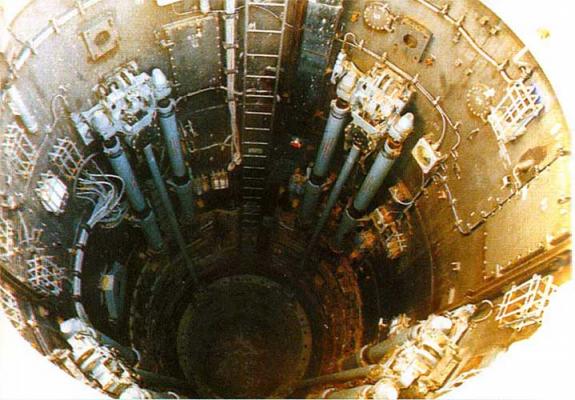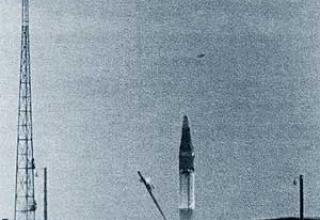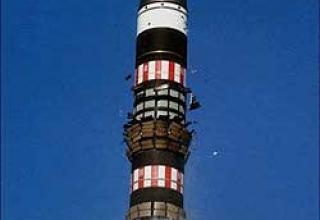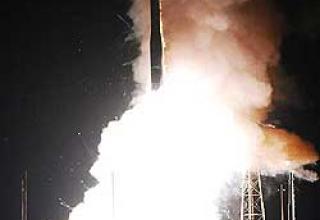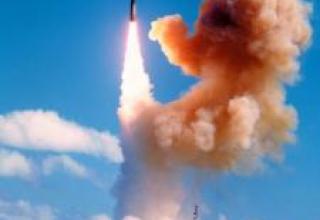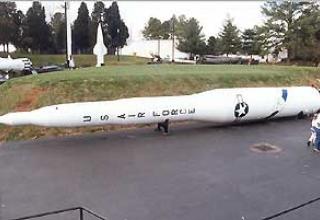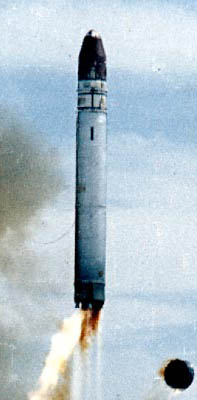
Just a few months after the adoption of the 15P015 complex with missile 15A15 (MR-UR100) on August 16, 1976 the Government of the USSR ordered Yuzhnoye SDO to develop the RK with improved tactical and technical characteristics. In December 1976 the conceptual design of the complex with 15A16 missile was developed and presented to the Customer.
The modernization of the complex was aimed at a significant increase in the efficiency of combat application with minimal modifications and mainly concerned the separating head unit and breeding stage. The first and second stages were used without any modifications, and the dilution stage was replaced by a new one directly on the fuel-fuelled SHU rocket. The design of the 15P716 high-security ground nuclear explosion launch facility was developed at the KBSM under the leadership of A.F.Utkin.
The 15P016 stationary strategic missile system with the "light" intercontinental missile of 15A16 class was adopted for service on December 17, 1980 by the USSR Government Decree. The first regiment with 15A16 missile system was put on combat duty on October 17, 1978. By 1983, all 15A15 missiles, which were on combat duty in the amount of 130 units were replaced by 15A16 missiles. In addition, due to the reduction of UR-100 missiles, 20 more missiles were deployed, which brought the total number of deployed 15A16 ICBMs to 150.
Currently, all these missiles have been dismantled and all IS have been eliminated, except for one (Bologoye), which has been left for museum purposes. The missiles were destroyed at the Surovatich range (Nizhny Novgorod Oblast).
Composition:
15A16 missile - intercontinental, ballistic, liquid, two-stage, ampulized. Fuel - liquid, self-ignition with high boiling components (fuel - NDMG, oxidizer-AT). Combat equipment of the missile - separable head unit with 4 nuclear explosion-resistant combat units (BB) with a charge of 0.5 Mt each.
The controls of the 1st stage - four-chamber steering LRD with rotary CS, the 2nd stage - main engine controlling the flight on pitch and yaw by means of gas injection system to the critical part of the nozzle and special nozzles operating on generator gas and controlling the flight on the heel
The peculiarity of RK 15P016 is that both stages of the missile, the head fairing and the body of the TPK were used without any modifications from RK 15P015, which made it possible to re-equip the missiles 15A15, which are on combat duty, in 15A16 without dumping the fuel components by replacing the GC, the container with the instruments of SC and check and launch equipment. This ensures the similarity of the composition of the DBK, continuity and complete unification of most systems and units with Kazakhstan 15P015.
RSC 16F161 missile 15A16 differed from RSC 15F154 missile 15A15 by a modified solid propulsion engine 15D171-02 with reduced thrust variation due to individual selection of critical nozzle cross-sections. New impulse-free devices for attachment of the AB to the platform and mechanisms for disconnection of plug connectors between the AB and the RSH were introduced.
For the first time in the practice of domestic rocket engineering the autonomous onboard aiming system "Meridian" was applied, which allows determining the direction of the true meridian with the help of azimuth-focused gyroplatform and ensuring the missile's aiming after a nuclear strike on the starting position. The Meridian system was able to remotely measure and refine the azimuth correction of the base element determined when placed on alert by visual gyrocompasses.
TTH improvement (1.5-2.5 times more effective combat application) as compared to 15A15 missile has been achieved due to the application of new SDHBs with increased TNT equivalent (1.25 times), improved control system and SDH dilution, which allowed to improve hit accuracy by 2 times. The control system is self-contained, inertial, allowing for re-targeting during pre-start preparation.
Technical operation of 15A16 missile is identical to 15A15 missile operation. Launch unit (15P716) - mine, automated, highly protected, of "OS" type - modernized PU "OS-84". The conditions of the missile's alert - being on full alert in the SHPU. Method of launch - mortar, from the TPC with the help of the PAD. Combat use is provided at any time of year and day, in any weather conditions, as well as after the impact of a nuclear explosion (within the protection of the ballistic missile).
Characteristics:
| General characteristics | |
| Targeting range, km - maximum - minimum |
10200 1000 |
| Firing accuracy, km - in the absence of an enemy nuclear strike at the starting position - when a missile is launched after a nuclear strike on its starting position |
0.84 1.05 |
| BB breeding area, km | 200х100 |
| Flight Reliability | 0.96 |
| Stand by, s | 60 |
| Warranty period of being on combat duty under the regulations once in 3 years, years | 10 |
| 15A16 missile | |
| Launching weight of the rocket, tc | 71.1 |
| Weight of the head end, kgs | 2050 |
| Overall dimensions, m: - length - diameter |
22.15 2.25 |
| Remote Control Features | |
| Circuit pull of the 1st stage (on the ground/in the void), ps: - main engine - steering engine |
117/126 28/33 |
| 2-stage traction in the void, shh. | 14.5 |
| Remote control specific pulse in the void, s: - Stage I - II stages |
318.5 330.5 |
Testing:
Flight tests of the 15P016 complex started at NIIP-5 in October 1977 and were completed in September 1979. Taking into account the fact that the first stages of the missile remained unchanged, the volume of LKI was reduced. The flight tests of the complex were conducted by the State Commission under the chairmanship of Major-General A.F.Dubovik. The main emphasis was placed on the development of a new control system, a new combat unit 15F162, on confirming the accuracy of firing and testing the process of re-equipping the missile system for a modified missile. During the flight tests 19 launches were conducted, 16 of which were successful. The reasons for the emergency launches were mainly accidental production defects - improper functioning of the feedback loops of the steering drives of the pitch and yaw of the second stage due to the use of a non-standard socket-jumper, failure of the command to separate the stages due to the violation of the plug connectors installed with the violation of documentation. One of the launches was with the most severe consequences. As a result of an error in recording the flight task, the command to start the first stage engine was not issued. After the mortar launch the rocket went up to 20m and collapsed into the launcher, which resulted in complete destruction of the CPU.
Flight tests confirmed an increase in the operational effectiveness of the complex by about 2.5 times compared to the 15P015 complex and allowed the State Commission to recommend it for service.
All the launches were conducted with 5 NIIP. Beginning of the LKI 1977. The end of the LKI 1979.
All the launches during the LKI:
- at Kura District 19
- number of emergency stops 3
- total number of launches made: 25
- of which there are 3 emergency cases
Successful launches - 88%.
On July 5, 1981 the planned volume of tests of PU 15P716 by seismic loading with an air shock wave (tests of "Argon-4" PSK-III) was successfully completed. Seismic sensors registered the calculated load, the foundations of F-1 and F-2 of the construction structure were shifted (the foundation for the installer's supports), the base element was destroyed, one RBU input failed. There were no destructions, deformations in the elements and the control panel equipment. In 1984 there were no deformations on elements and equipment of the control panel. PU 15P716 was tested for increased mechanical impact. The equipment of starting installation has passed the test.
Sources:
- "Призваны временем. Ракеты и космические аппараты конструкторского бюро "Южное"./ Под общей редакцией С.Н.Конюхова/. Д.: Арт-Пресс, 2004,-232с.
- "КБ специального машиностроения: От артиллерийских систем до стартовых комплексов" (под редакцией Ушакова В.С.) .СПб, 2004.
- Карпенко А.В., Уткин А.Ф., Попов А.Д. "Отечественные стратегические ракетные комплексы". СПб, Невский бастион-Гангут 1999 год.

